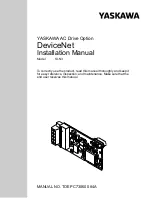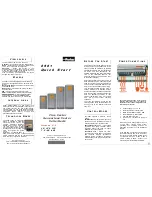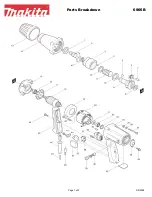
Proper Use Of The Tool
Your new 3/8” Drive Impact Wrench is designed for
driving, tightening and loosening threaded
fasteners, usually nuts and bolts, when fitted with
a suitable impact socket.
Always use impact-rated extension bars, universal
joints and socket adapters between the square
output drive of the impact wrench and the female
square drive of the socket.
Do not use the tool for any other purpose than that
specified without consulting the manufacturer or
the manufacturer’s authorized supplier. To do so
may be dangerous.
Never use the impact wrench as a hammer to
dislodge or straighten cross threaded fasteners.
Never attempt to modify the tool for other uses.
Work Stations
Your impact wrench should only be used as a hand
operated tool. It is always recommended that the
tool is used when standing with solid footing. It
can be used in other positions but before any such
use, the operator must be in a secure position
having a firm grip and footing and be aware that
when loosening fasteners the tool can move quite
quickly away from the fastener being undone. An
allowance must always be made for this rearward
movement so as to avoid the possibility of hand/
arm/body entrapment.
Putting Into Service
Air Supply
Use a clean lubricated air supply that will give a
measured air pressure at the tool of 90 psi/6.2 bar
when the tool is running with the trigger fully
depressed. Use recommended hose size and
length. It is recommended that the tool is
connected to the air supply as shown in figure A.
Do not connect the tool to the air line system
without incorporating an easy to reach and operate
air shut off valve. The air supply should be
lubricated. It is strongly recommended that an air
filter, regulator, lubricator (FRL) is used as shown
in figure A as this will supply clean, lubricated air
at the correct pressure to the tool. Details of such
equipment can be obtained from your supplier. If
such equipment is not used then the tool should
be lubricated by shutting off the air supply to the
tool and then depressurizing the line by pressing
the trigger on the tool. Disconnect the air line and
pour into the intake bushing a teaspoon (5 ml) of a
suitable pneumatic motor lubricating oil,
preferably incorporating a rust inhibitor. Reconnect
tool to air supply and run tool slowly for a few
seconds to allow air to circulate the oil.
Lubricate tool daily if used frequently, or when it
starts to slow or lose power.
Operating Instructions
Securely fit the socket or attachment to the impact
wrench. Ensure that the forward/reverse button is
in the correct position for tightening or loosening
the fastener.
The nut/bolt can then run down the thread using
the power drive of the tool.
For loosening a joint the tool can be used in the
reverse sequence.
Using An Impact Wrench
1)
Read all instructions before using this tool. All
operators must be fully trained in its use and
aware of these safety rules.
2)
Do not exceed the maximum working air
pressure of 90 psi/6.2 bar.
3)
Use personal safety equipment.
4)
Use only compressed air at the recommended
conditions.
5)
If the tool appears to malfunction, remove
from use immediately and arrange for service
and repair.
6)
If the tool is used with a balancer or other
support device, ensure that it is fixed securely.
7)
Always keep hands away from the working
attachment fitted to the tool.
8)
The tool is not electrically insulated. Never use
the tool if there is any chance of it coming into
contact with live electricity.
9)
When using the tool, always adopt a firm
footing and/or position and grip the tool firmly
to counteract any forces or reaction forces that
may be generated while using the tool.
10) Use only correct spare parts. Do not improvise
or make temporary repairs.
11) Do not lock, tape, wire, etc. the on/off trigger
in the run position. The trigger must always be
free to return to the “off” position when it
is released.
12) Always shut off the air supply to the tool and
depress the trigger to release air from the feed
hose before fitting, adjusting or removing the
working attachment.
13) Check hoses and fittings regularly for wear.
Replace if necessary. Do not carry the tool by
its hose. Ensure the hand is removed from the
on/off trigger when carrying the tool with the
air supply connected.
14) Take care against entanglement of moving tool
parts with clothing, ties, hair, cleaning rags,
etc. This will cause the body to be drawn
towards the tool and can be very dangerous.
15) It is expected that users will adopt safe
working practices and observe all relevant
legal requirements when installing, using or
maintaining the tool.
16040
Specifications
Especificaciones
Fiche technique
US
F
E
Average Air
Consumption
2.2 CFM (16 SCFM)
100% Usage
Promedio de
consumo de aire
2.2 CFM (16 SCFM)
Uso al 100%
Consommation
moyenne d’air
2,2 pi
3
/min (16 SCFM)
Usage à 100 %
Mechanism
Jumbo Hammer
Mecanismo
Martillo Jumbo
Mécanisme
Marteau jumbo
Maximum RPM
9,000
Máximas RPM
9.000
Régime en tr/min
maximum
9 000
Max. Torque
180 ft-lb
Torsión máxima
180 lbs. pie
Tosion maximale
180 pi-lb
Air Inlet
1/4" NPT (F)
Entrada de aire
Rosca de 1/4 pul.
NPT (Hembra)
Entrée d’air
Taraudage de
6,35 mm NPT (F)
Weight
2,7 lbs.
Peso
2,7 lbs.
Poids
2,7 lb
Min. Hose Size
3/8"
Tamaño mínimo de
la manguera
3/8 pul.
Taille minimale du
tuyau
9,5 mm (3/8 po)
Square Drive
3/8”
Cuadrante
3/8 pul.
Carré
d’entraînement
9,5 mm (3/8 po)
Exhaust
Handle
Escape
Mango
Échappement
Poignée
Max. PSI
90
Lbs./pul
2
(PSI)
necesarias
90
Pression requise
en lb/po
2
90

























